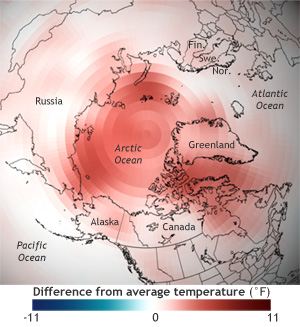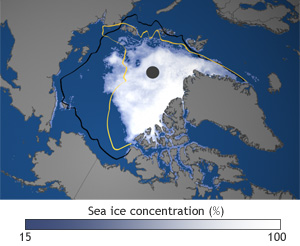
This is a reprint of a news release issued by the US National Oceanic and Atmospheric Administration (NOAA) on Dec 5, 2012.
The Arctic region continued to break records in 2012—among them the loss of summer sea ice, spring snow cover, and melting of the Greenland ice sheet. This was true even though air temperatures in the Arctic were unremarkable relative to the last decade, according to a new report released today (Dec 5, 2012).

Difference from average temperature in the Arctic from 2001-2011 compared to the long-term average (1971-2000). Credit: NOAA
"The Arctic is changing in both predictable and unpredictable ways, so we must expect surprises,” said Jane Lubchenco, Ph.D., under secretary of commerce for oceans and atmosphere and NOAA administrator, during a press briefing at the American Geophysical Union annual meeting in San Francisco, Calif. “The Arctic is an extremely sensitive part of the world and with the warming scientists have observed, we see the results with less snow and sea ice, greater ice sheet melt and changing vegetation.”
Lubchenco participated in a panel discussion that presented the annual update of the Arctic Report Card, which has, since 2006, summarized the quickly changing conditions in the Arctic. A record-breaking 141 authors from 15 countries contributed to the peer-reviewed report. Major findings of this year’s report include:
“Popular perceptions of the Arctic as a distant, icy, cold place that has little relevance to those outside the region are being challenged”, said Martin Jeffries, co-editor of the 2012 Report Card and Arctic science adviser, Office of Naval Research & research professor, University of Alaska-Fairbanks. “As snow and ice retreat, the marine and terrestrial ecosystems respond, and talk of increased tourism, natural resource exploitation, and marine transportation grows. The Arctic Report Card does a great service in charting the many physical and biological changes.”

Ice concentration on Sept. 16, 2012, compared to previous record low (yellow line) and historic median extent (black line.) Credit: NOAA/National Snow & Ice Data Center.
Apart from one or two exceptions, the scientists said the air temperatures were not unusually high this year relative to the last decade. Nevertheless, they saw large changes in multiple indicators affecting Arctic climate and ecosystems; combined, these changes are strong evidence of the growing momentum of Arctic environmental system change.
The record-breaking year also indicates that it is unlikely that conditions can quickly return to their former state.
“The record low spring snow extent and record low summer sea ice extent in 2012 exemplify a major source of the momentum for continuing change,” added Jeffries. “As the sea ice and snow cover retreat, we’re losing bright, highly reflective surfaces, and increasing the area of darker surfaces—both land and ocean—exposed to sunlight. This increases the capacity to store heat within the Arctic system, which enables more melting—a self-reinforcing cycle.”
In 2006, NOAA’s Climate Program Office introduced the State of the Arctic Report which established a baseline of conditions at the beginning of the 21st century. It is updated annually as the Arctic Report Card to monitor the often-quickly changing conditions in the Arctic. To view this year’s report, visit http://www.arctic.noaa.gov/reportcard/.
Posted by John Hartz on Sunday, 23 December, 2012
 |
The Skeptical Science website by Skeptical Science is licensed under a Creative Commons Attribution 3.0 Unported License. |